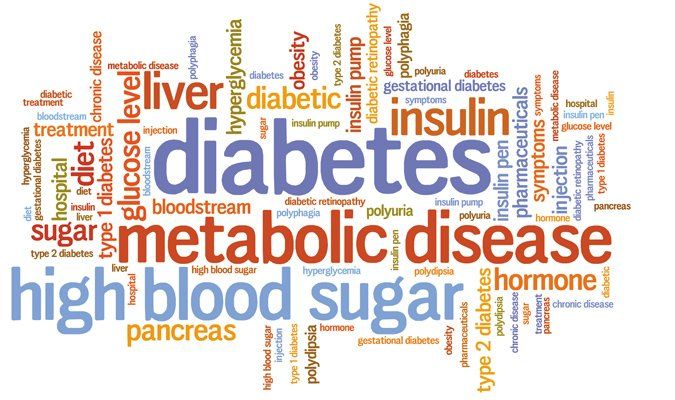The prevalence of diabetes is rapidly rising in every country around the world. According to the American Diabetes Association (ADA), nearly 10 percent of the U.S. population—more than 30 million Americans—has diabetes. Another 84 million adults have prediabetes. And, at least a quarter of people with diabetes and the vast majority with prediabetes don’t even know they have it. If things don’t change, about two in five Americans will develop diabetes in their lifetime.
The two main types of diabetes are called type 1 and type 2. Type 1 is much less common, affecting only about five percent of people with diabetes. It is characterized by a total lack of insulin due to autoimmune attacks on the insulin-producing beta-cells of the pancreas, which leads to high blood sugar levels. People with type 1 diabetes must take insulin to survive. The far more common type 2 diabetes is strongly linked to obesity, especially central fat in the liver and around the organs. It is not characterized by a lack of insulin (high blood insulin levels are actually common) but by resistance of the body’s cells to the normal effects of insulin. Type 2 diabetes used to be seen only in adults, but now is increasingly common in children, due to the obesity epidemic. Diabetes is diagnosed through a range of different blood tests that utilize fasting blood glucose, blood glucose levels following a test meal, or hemoglobin A1C levels. Prediabetes is diagnosed when these values are higher than normal, but not yet at the diabetes threshold.
With so much confusion about diabetes, so many people affected, and the rates rising rapidly, it’s time to address some diabetes facts and myths, with a focus on the more common type 2 diabetes.

Image © ratmaner | Getty Images
Myth #1: Sugar is the cause of diabetes. Consuming lots of sugar will complicate diabetes management, but sugar alone does not cause diabetes, explains Anastassios G. Pittas, MD, MS, professor of medicine in the Division of Medicine at Tufts Medical Center. Major risk factors for type 2 diabetes and prediabetes include being overweight or obese, especially in the presence of central or visceral fat; being physically inactive; smoking; and poor diet. Renata Micha, a research associate professor at Tufts Friedman School of Nutrition Science and Policy, systematically reviewed all the evidence for dietary factors that influence onset of diabetes. She found the strongest evidence for low intakes of nuts, seeds, whole grains, and dietary fiber, as well as high intakes of processed meats, high glycemic carbohydrates (such as refined starch and sugar), and red meats.
Myth-busting advice: Avoiding foods high in added sugars will improve the quality of your diet, but is not the only thing necessary to prevent type 2 diabetes. Eating more nuts, seeds, whole grains, and other fiber-rich foods; avoiding processed meats and limiting refined starch and red meats; engaging in regular physical activity; and not smoking are also important.
Myth #2: I only need to focus on my blood sugar. While blood sugar management is critical, it is not the only important factor. Type 2 diabetes also causes abnormalities in fat metabolism, blood cholesterol levels, blood pressure, inflammation, blood vessel function, blood clotting, and the immune system. Many drug treatments for diabetes only target blood sugar levels, leaving these other risk factors unchanged. These factors greatly increase the risk for cardiovascular disease (the leading cause of death and serious illness among people with diabetes) as well as cancer and infection.
Myth-busting advice: Focus on healthy food choices and lifestyle habits, and medications as necessary for the management of all aspects of your health, not only your blood sugar.
Myth #3: I have to avoid all carbohydrates. Because carbohydrate-containing foods can raise blood sugar levels more than other foods, many people with diabetes and prediabetes believe they need to severely limit intake of all carbohydrates. That’s not accurate, says Pittas. “It’s important to distinguish between healthful foods with carbohydrates and unhealthful foods with carbohydrates,” he says. For example, fruits, vegetables, minimally processed whole grains, legumes, yogurt, and cheese are health-promoting choices that contain carbohydrates.
“The quality of the diet is essential to preventing and treating type 2 diabetes,” says Dariush Mozaffarian, MD, DrPH, dean of the Friedman School and editor-in-chief of Tufts Health & Nutrition Letter. “It’s overly simplistic to focus solely on either total carbohydrates or total calories. I recommend eating plenty of healthy fats from nuts, seeds, fish, avocados or other vegetables and fruit, nut, and seed oils, while avoiding foods rich in refined starch and sugar like white bread, white rice, most cereals and crackers, and of course candy and soda.” Mozaffarian worries that an increasing trend toward very low-carb, ketogenic diets is turning some people toward processed meats and red meats as the main alternative, which will improve blood sugar control in the short term but may ultimately damage the pancreas due to excessive heme iron from meats. “People who eat more red meat and especially processed meat have higher, not lower, risk of developing type 2 diabetes.”
A variety of eating patterns that include healthy foods containing more slowly digested carbohydrates are suitable for people with diabetes, including vegetarian and Mediterranean-style dietary patterns. “For carbohydrates, it’s really about the dose and the rate of digestion,” explains Mozaffarian. “A low, slowly digested dose of carbs, such as in a berry or apple, also comes with lots of beneficial phytochemicals and is great for metabolic health.” In a 2015 meta-analysis of randomized controlled trials published in the European Journal of Clinical Nutrition, the Mediterranean-style diet was superior to control diets in improving blood sugar control, cardiovascular risk factors, and body weight among people with type 2 diabetes. In another meta-analysis of observational studies among more than 100,000 participants from around the world, researchers found that individuals whose diets most closely resembled a Mediterranean-style diet were 23 percent less likely to develop diabetes.
Myth-busting advice: Avoiding carbs will help blood sugar control but is not the optimal solution. For best health, Mozaffarian urges people to reduce highly refined starches and added sugars and replace these foods with nuts, seeds, fish, non-starchy vegetables, plant oils, yogurt, cheese, minimally processed whole grains, fruits, beans, and poultry. For heart health as well as blood sugar management, foods with viscous fibers such as beans, lentils, oats, and barley can be helpful. Such a diet is also good for our gut microbes, which rely on a host of fibers to thrive, in turn benefiting our health.
Myth #4: I need to focus on aerobic exercise for weight loss to control my blood sugar. All types of physical activity are beneficial for type 2 diabetes. Importantly, even without weight loss, physical activity improves insulin resistance, blood glucose levels, central obesity, and most other risk factors associated with diabetes. So, be active for your health, not your weight.
Myth-busting advice: The ADA recommends at least 150 minutes of moderate-intensity physical activity, such as brisk walking, swimming, gardening, dancing, biking, or other sports each week. Spread activity out over at least three days, with no more than two consecutive days without it.
Because muscle is an important place for blood sugar to go after eating, maintain or build muscle with resistance (strength) training—such as using exercise bands or lifting weights—two to three times weekly. Break up too much sitting with at least three minutes of walking, leg lifts, or other light activity every 30 minutes to stimulate muscles.
Myth #5: Type 2 diabetes is incurable. This is an increasingly controversial idea. While some experts believe there is no cure for type 2 diabetes, meaningful weight loss, a healthy diet, and exercise can lead to complete normalization of blood glucose and other physiologic abnormalities seen in type 2 diabetes. A 2016 study of people at risk for developing type 2 diabetes found that losing only five percent of body weight was associated with improved insulin sensitivity in fat, muscle, and liver cells; better function of the pancreatic beta-cells; and reduced liver fat. As subjects lost more weight, they experienced even greater insulin sensitivity and beta-cell function.
A healthy diet, exercise, and weight loss can greatly improve metabolic parameters and reduce or even eliminate the need for medications.
Myth-busting advice: Losing even five to 10 percent of excess weight may not cure type 2 diabetes, but it can greatly improve the condition and also has many other health benefits. Additionally, a healthy diet and physical activity are independently beneficial, regardless of weight loss. Together, these beneficial lifestyle changes can reduce many people’s metabolic parameters back to normal.






















What about intermittent fasting?
I wish you would put the symptoms for diabetes.
I wish you would put the symptoms for diabetes. I enjoy reading your articles since I’m an 80 year old lady in good health in spite of this pandemic which, so far, I’ve dodged.
This is a nice and informative article. Thank you.